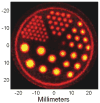Silicon detectors for combined MR-PET and MR-SPECT imaging
- PMID: 23440608
- PMCID: PMC3578311
- DOI: 10.1016/j.nima.2012.08.040
Silicon detectors for combined MR-PET and MR-SPECT imaging
Abstract
Silicon based devices can extend PET-MR and SPECT-MR imaging to applications, where their advantages in performance outweigh benefits of high statistical counts.Silicon is in many ways an excellent detector material with numerous advantages, among others: excellent energy and spatial resolution, mature processing technology, large signal to noise ratio, relatively low price, availability, versatility and malleability. The signal in silicon is also immune to effects of magnetic field at the level normally used in MR devices. Tests in fields up to 7 T were performed in a study to determine effects of magnetic field on positron range in a silicon PET device. The curvature of positron tracks in direction perpendicular to the field's orientation shortens the distance between emission and annihilation point of the positron. The effect can be fully appreciated for a rotation of the sample for a fixed field direction, compressing range in all dimensions. A popular Ga-68 source was used showing a factor of 2 improvement in image noise compared to zero field operation. There was also a little increase in noise as the reconstructed resolution varied between 2.5 and 1.5 mm.A speculative applications can be recognized in both emission modalities, SPECT and PET.Compton camera is a subspecies of SPECT, where a silicon based scatter as a MR compatible part could inserted into the MR bore and the secondary detector could operate in less constrained environment away from the magnet. Introducing a Compton camera also relaxes requirements of the radiotracers used, extending the range of conceivable photon energies beyond 140.5 keV of the Tc-99m.In PET, one could exploit the compressed sub-millimeter range of positrons in the magnetic field. To exploit the advantage, detectors with spatial resolution commensurate to the effect must be used with silicon being an excellent candidate. Measurements performed outside of the MR achieving spatial resolution below 1 mm are reported.
Keywords: PET; silicon detectors.
Figures



References
-
- Straver J, et al. One micron resolution with silicon strip detectors. Nucl Inst Meth A. 1994;348(2–3):485–490.
-
- Studen A, et al. Development of silicon pad detectors and readout electronics for a compton camera. Nucl Inst Meth A. 2003;501:273–279.
-
- Studen A, et al. A silicon pet probe. Nucl Inst Meth A. 2011;648(S1):S255–S258.
-
- Cochran E, et al. Performance of electronically collimated spect imaging system in the energy range from 140 kev to 511 kev. IEEE NSS Conf Rec. :4618–21.
Grants and funding
LinkOut - more resources
Full Text Sources
Other Literature Sources
